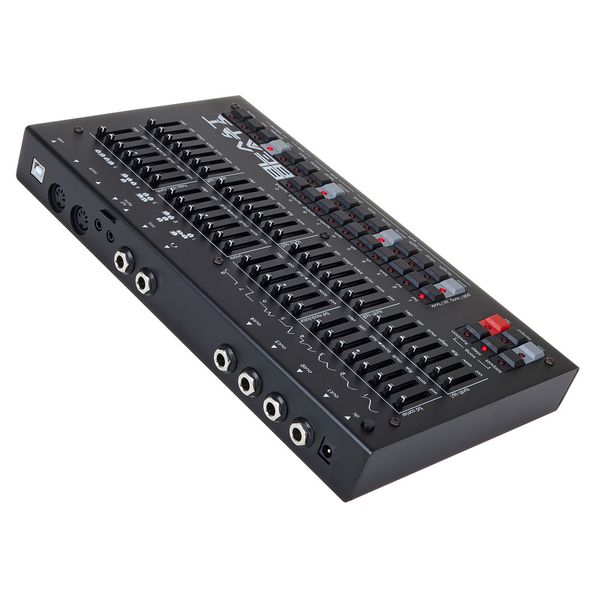This boombox is quite unique. It is based around the ymf262 soundchip (opl3), an absolute classic from the DOS era of gaming, with a very distinct sound. If you're already familiar with Twisted Electrons, you know about the MEGAfm, based around the chip used in the SEGA Megadrive, and the TherapSID, I believe from the Commodore 64. There is nothing like this out there; the chip still isn't perfectly emulated in software, and at this time there is no other existing project, indie or otherwise, which surpasses the Blast Beats in terms of music making.
Out of the channels supported by opl3, the Blast Beats uses 4 melodic and 6 percussions; instead of merging all drum sounds in one, it splits bass drum, snares, tom, open high hat, closed high hat, crash cymbal, although the last three share configuration. Each is controlled by 7 faders (x2 for bass drum) for a bunch of parameters. Instruments can be selected individually with one dedicated button for each. The sequencer is used via 16 buttons, for a maximum of 64 steps divided in 4 pages. Quantization can be turned off and microdelays set per step. There are a few effects like wiggle, swing; probality of triggers, mute; there is also freeze, stutter and bend down (for all channels simultaneously). There is a 1 step undo, a song mode; kits, patterns and songs are saved separately on an sd card in some undocumented format, but it would be easy to figure it out. There can be up to 16 sets of 16 patterns each in each of the 10 banks. Kits are drum and melodic instruments fader settings. There is also fader and effect automation, copy, paste, cut, etc. There can be 10 sets of kits with 10 selectable variants each. There is MIDI controls for all faders, MIDI channels can be split between 4 outputs, there is MIDI or CV sync. There now is a webtool to configure MIDI routing and a bunch of options. The usb is only for firmware updates. No issues with polyphony; most melodic instruments are mono, but some algorithms (out of 8 possible) make them 2-voice. There is step editing and a bunch of other stuff. I'm sure I'm forgetting a couple of other features, but all in all everything you need to make cool tunes is there, unlike say the MEGAfm which has a very limited sequencer. The box itself is rock solid (minus issues below). There are firmware updates fairly often and they frequently add new features: the latest one adds a VGM file jukebox so you can play all the tunes you know and love on it by just placing them on the sd card! The sd card makes backups and recall very convenient.
It is indeed unfair to call this just a drum machine. The box is just amazing. In a way, the high price is almost completely justified.
However, there are a few serious issues that can completely ruin the experience:
- The learning curve is steep; everything besides instrument configuration with the faders is done through button combinations, and you absolutely need to download the manual, and read the firmware update release notes, and even then some stuff is undocumented. On the plus side the manual also receives updates, but I still need to have it open even after several months, because I just keep mixing commands up.
- Bugs in the firmware and regressions are present after almost every single update; sometimes you can reach out to its maker and they might respond, but generally you have no choice but to wait for the next update. I've had bugs with pattern length, freezing requiring restarts, kits randomly corrupting themselves (backups are mandatory), patterns getting fader settings out of nowhere, etc etc. It is infuriating when your pattern or kit suddenly changes up under you and sounds different, or gets random kit changes in the middle of a pattern. Sometimes I've managed to reset them, sometimes not. The firmware blob in the box which one overwrites to update it got corrupted, the file appeared garbled, and I had to format the partition from Windows every time. There's no way to fix it from the user's side.
- Potential hardware problems: another reviewer here noted an issue with a fader which they fixed with deoxite, but that magical substance is mostly unavailable in Europe and expensive on eg. ebay. I also had a problem, but essentially one fader completely failed and should've been replaced, there was no other way. I sent it back for repair and was told a month later that it couldn't be repaired and there were no available units for replacement, so I got refunded and my box just taken away. It is assembled manually by a small team so of course there are very frequent shortages.
- Incomplete MIDI implementation. No MIDI thru, no configuration of output channels (output channels mirrored from input!). The only things driven by MIDI are the fader settings and instrument triggers. No mod wheel, no pitch bend, no bank management, pattern selection, etc
- Missing opl3 features. Perhaps more minor, but the chip is capable of more and it's disappointing not to have them. The biggest are a limited range of octaves in the lows when the chip clearly supports more (as other projects evidence) and no bend up, only down, though with selectable speed and quite some range, and no panning. Why? It artificially limits sonic possibilities, when you could easily come up with ways to control this with the interface.
Over all, it is an utterly insane instrument and I love it; all the same, expect problems, some of which can be extremely annoying. Protect the hardware to avoid issues with all the moving parts. We'll see what the longetivity is like, but I'm quite scared of random failures.


























